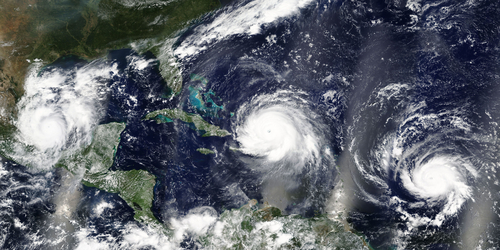
According to a new paper from researchers at the Pacific Northwest National Laboratory (PNNL), hurricane season is set to worsen in the years ahead in terms of strength and frequency as global warming empowers storms along the U.S. East and Gulf Coasts.
Hurricane frequency could rise by as much as a third of current levels, according to the paper published in the journal Science Advances.
This is being fueled by changes in the winds of Earth’s upper atmosphere as the sea surface of the Eastern Pacific Ocean itself warms. Previous studies also showed that vertical wind shear will weaken as the world warms, meaning a force that typically weakens hurricanes will falter as changes to the world that increase the frequency of hurricanes surge. Coupled with other research that projected hurricanes may begin moving more slowly, this means stronger, more common hurricanes that will last longer.
“What we found is that these wind changes have a double whammy effect,” Karthik Balaguru, lead author and climate scientist, said. “First, they steer storms closer to the U.S. East and Gulf coasts, which brings risk to the people who live there. But these same wind changes also reduce vertical wind shear near the coast, and that will ultimately strengthen coastal storms. When these two factors work together, it exacerbates the whole problem.”
Warming wind and weakening wind shear marked a major revelation for the scientists, signaling a greater understanding of the reason behind major changes rather than defaulting to the more general global warming and extreme weather.
Balaguru and his team created a unique model for their efforts known as RAFT, which factored in winds and waters, and got around the traditional, computationally expensive. These could be combined with climate models to generate simulated storms and provide greater statistical analyses. RAFT generated hundreds of hurricane paths.
Ultimately, the mechanism behind rising hurricane frequency can all be tracked to warming waters in the Eastern Pacific. Warmer sea surface leads to increased evaporation, which causes warmer, moister air to reach the atmosphere. The sea surface in the Eastern Pacific Ocean is traditionally cooler. Greenhouse gas emissions continue to rise, and as they do, they trap more and more heat. Land and sea surfaces then continue heating, causing the process to double down through convection and a pattern of planetary-scale waves in the atmosphere – Rossby waves – that influence great distances and major circulation patterns, triggering changes in the winds in the upper and lower troposphere.
“We saw that storm frequency near the coast was changing,” Balaguru said. “But why? Is it because the storms are getting stronger? Is it because they’re heading more in that direction? Our approach helped us isolate the key variables at play and determine which was most important.”
Some uncertainties remain, the scientists admitted, so further study and better modeling are planned.




